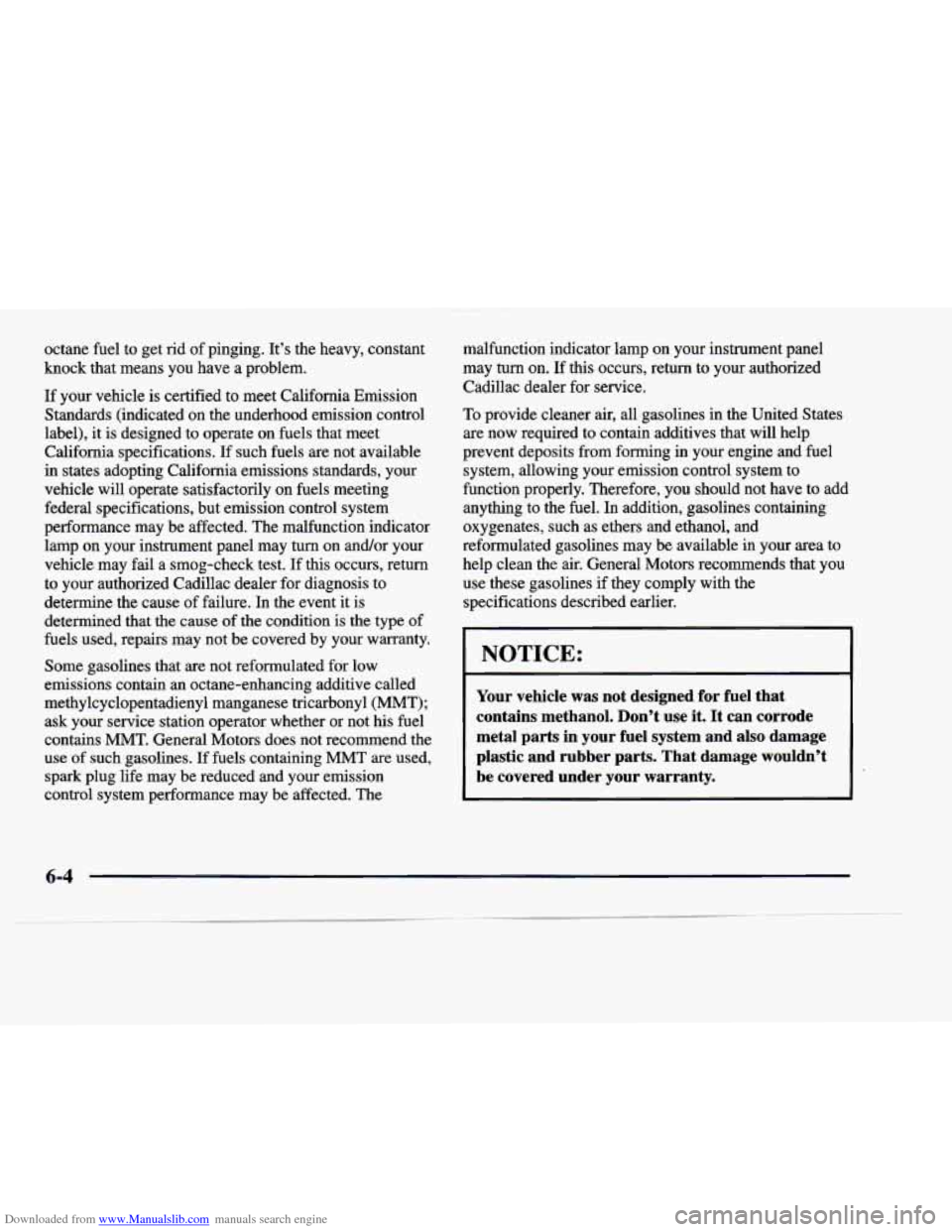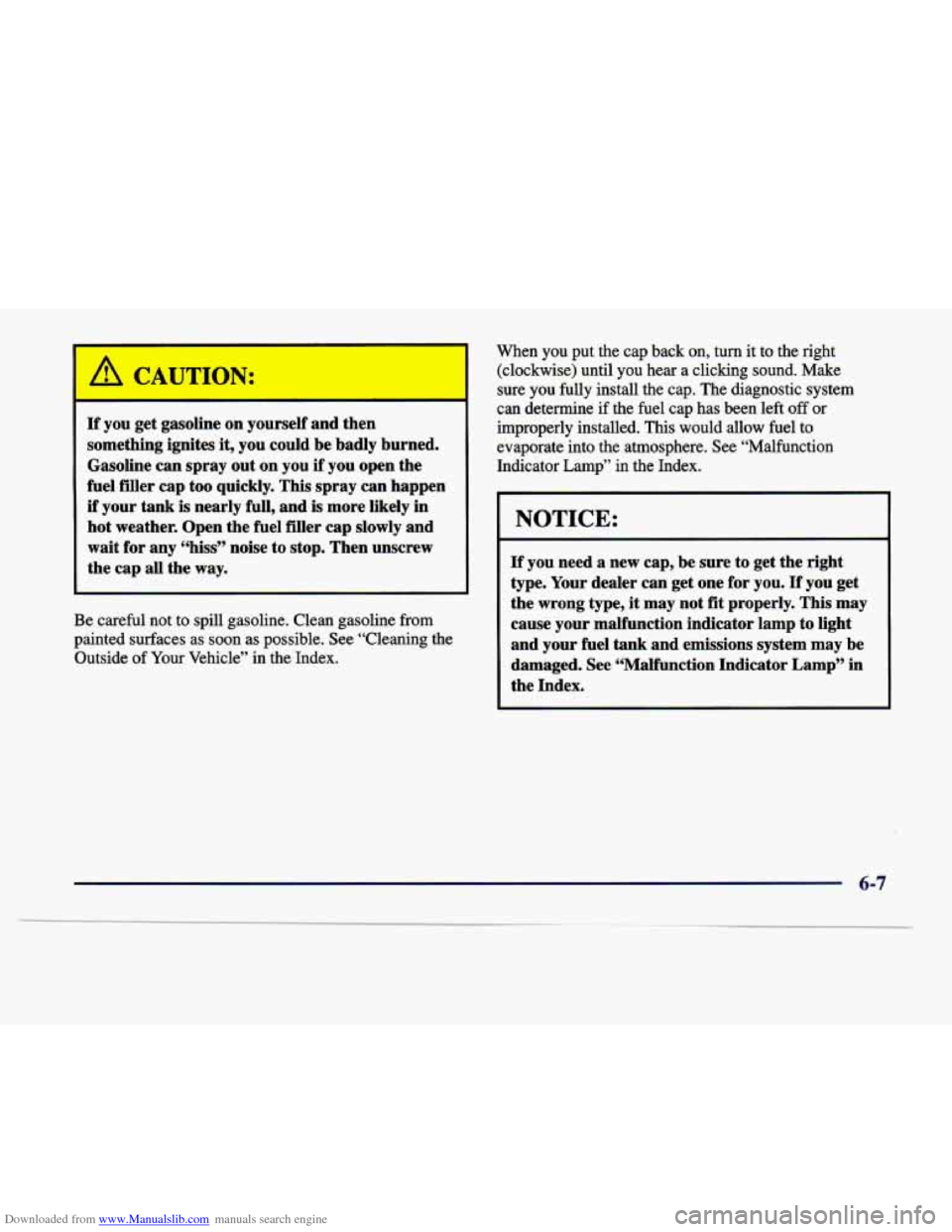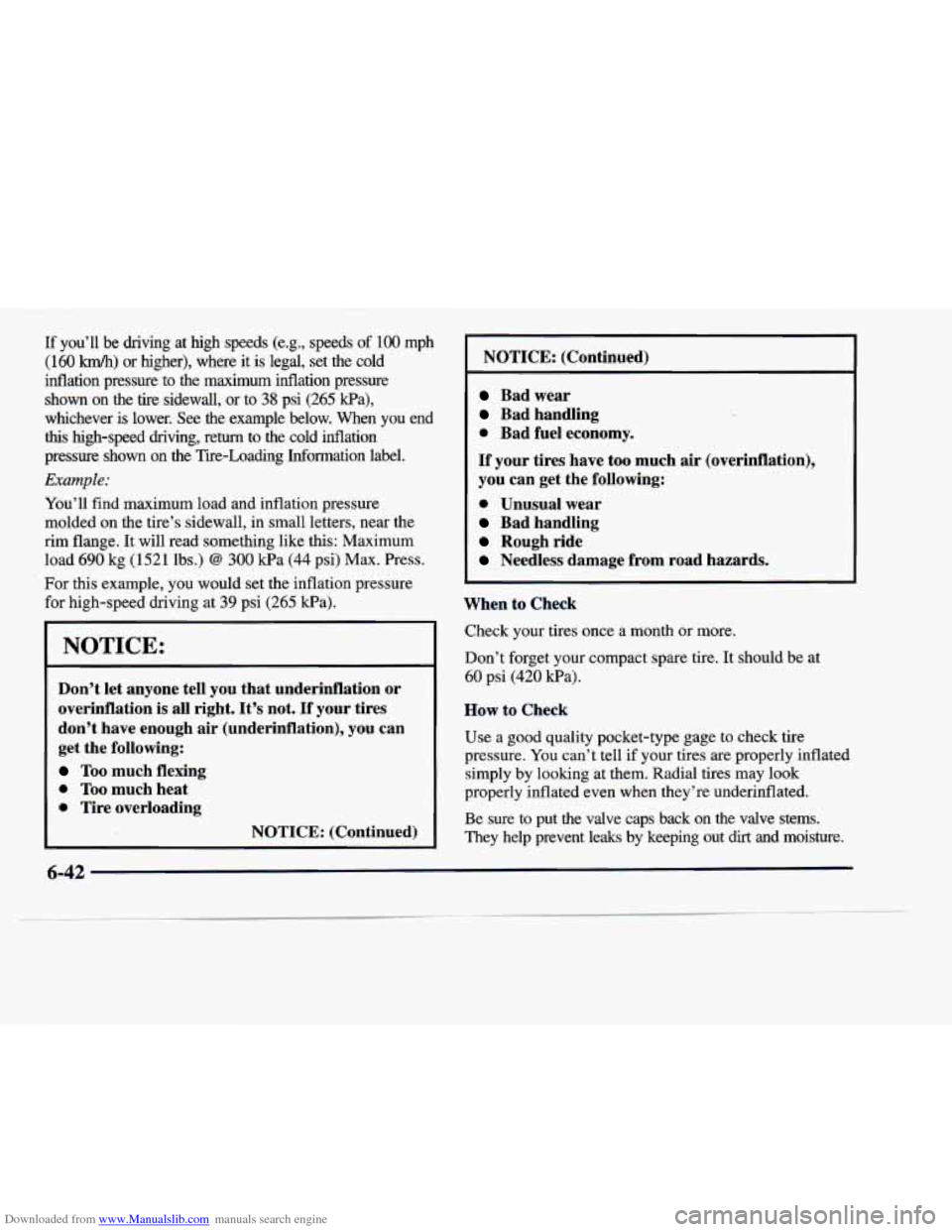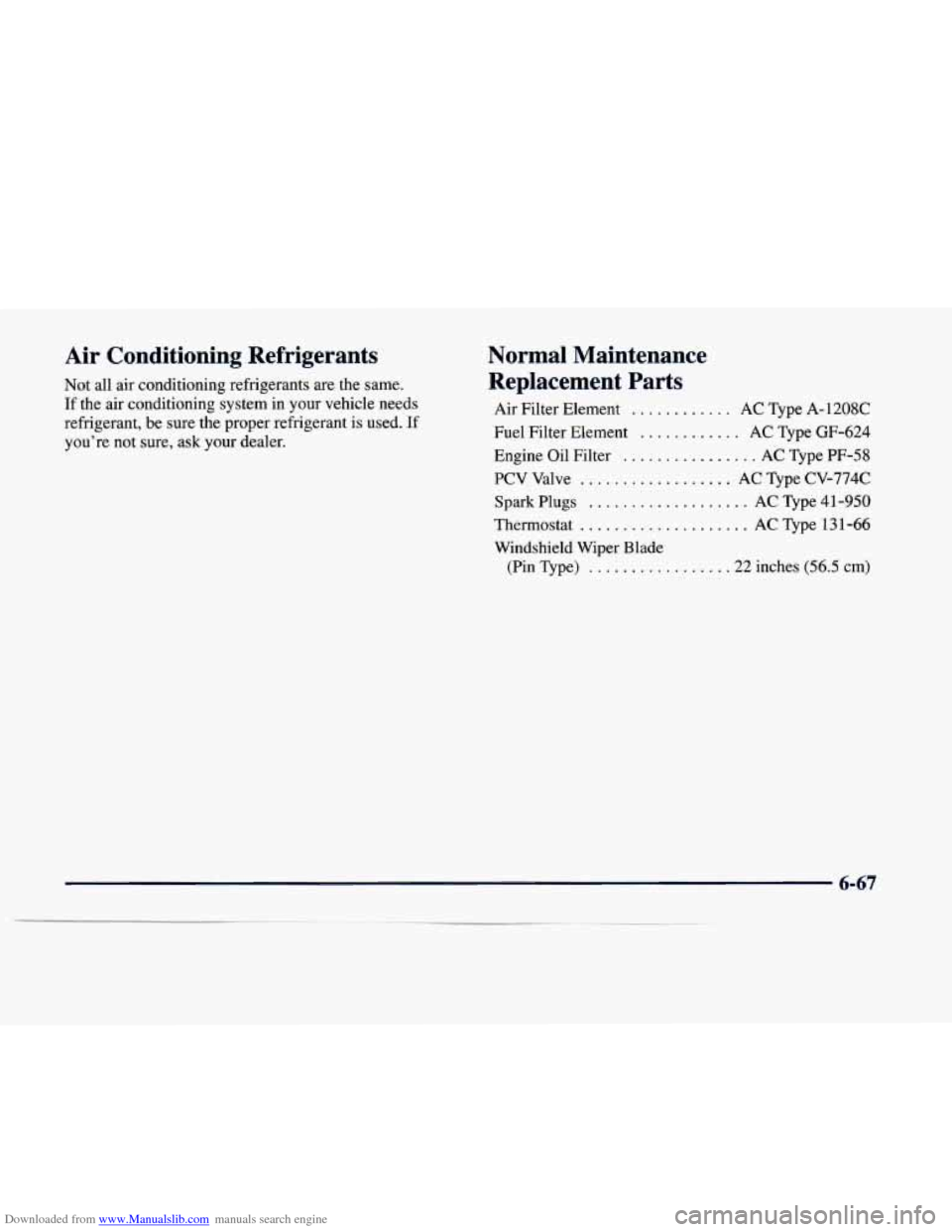fuel type CADILLAC DEVILLE 1998 7.G Owners Manual
[x] Cancel search | Manufacturer: CADILLAC, Model Year: 1998, Model line: DEVILLE, Model: CADILLAC DEVILLE 1998 7.GPages: 386, PDF Size: 22.36 MB
Page 291 of 386

Downloaded from www.Manualslib.com manuals search engine octane fuel to get rid of pinging. It's the heavy, constant
knock that means you have a problem.
If your vehicle is certified to meet California Emission
Standards (indicated on the underhood emission control
label), it is designed to operate on fuels that meet
California specifications.
If such fuels are not available
in states adopting California emissions standards, your
vehicle will operate satisfactorily on fuels meeting
federal specifications, but emission control system
performance may be affected. The malfunction indicator lamp on your instrument panel may turn
on andor your
vehicle may
fail a smog-check test. If this occurs, return
to your authorized Cadillac dealer for diagnosis to
determine the cause of failure. In the event it is determined that the cause of the condition is the type of
fuels used, repairs may not be covered by your warranty.
Some gasolines that are not reformulated for low
emissions contain an octane-enhancing additive called
methylcyclopentadienyl manganese tricarbonyl (MMT); ask your service station operator whether or not his fuel
contains MMT. General Motors does not recommend the
use .of such gasolines. If fuels containing
MMT are used,
spark plug life may be reduced and your emission
control system performance may be affected. The malfunction indicator lamp on your instrument panel
may turn
on. If this occurs, return to your authorized
Cadillac dealer for service.
To provide cleaner air, all gasolines in the United States are now required to contain additives that will help
prevent deposits from forming in your engine and fuel system, allowing your emission control system to
function properly. Therefore,
you should not have to add
anything to the fuel. In addition, gasolines containing
oxygenates, such as ethers and ethanol, and
reformulated gasolines may be available in your area to
help clean the air. General Motors recommends that you
use these gasolines if they comply with the
specifications described earlier.
NOTICE:
Your vehicle was not designed for fuel that
contains methanol. Don't use it. It can corrode
metal parts in your fuel system and also damage plastic and rubber parts. That damage wouldn't
be covered under your warranty.
6-4
Page 294 of 386

Downloaded from www.Manualslib.com manuals search engine If you get gasoline on yourself and then
something ignites
it, you could be badly burned.
Gasoline can spray out on you
if you open the
fuel filler cap too quickly. This spray can happen
if your tank is nearly
full, and is more likely in
hot weather. Open the fuel filler cap slowly and
wait for any L‘hiss” noise to stop. Then unscrew
the cap all the
way.
Be careful not to spill gasoline. Clean gasoline from
painted surfaces as soon as possible. See “Cleaning the
Outside of
Your Vehicle” in the Index. When you put the
cap back on,
turn it to the right
(clockwise) until you hear a clicking sound. Make
sure you fully install the cap. The diagnostic system
can determine if the fuel cap has been left
off or
improperly installed. This would allow fuel to
evaporate into the atmosphere. See “Malfunction
Indicator Lamp” in the Index.
I 3
I NOTICE:
If you need a new cap, be sure to get the right
type. Your dealer can get one for you.
If you get
the wrong type, it may not
fit properly. This may
cause your malfunction indicator lamp to light
and your fuel tank and emissions system may be
damaged. See “Malfunction Indicator Lamp” in
the Index.
Page 329 of 386

Downloaded from www.Manualslib.com manuals search engine - -
If you’ll be driving at high speeds (e.g., speeds of 100 mph
(160 km/h) or higher), where it is legal, set the cold
inflation pressure to the maximum inflation pressure shown on the
tire sidewall, or to 38 psi (265 kpa),
whichever is lower. See the example below. When you end
this high-speed driving, return to the cold inflation
pressure shown on the Tire-Loading Information label.
Example:
You’ll find maximum load and inflation pressure molded
on the tire’s sidewall, in small letters, near the
rim flange. It will read something like this: Maximum load 690
kg (1521 lbs.) @ 300 Wa (44 psi) Max. Press.
For this example,
you would set the inflation pressure
for high-speed driving at
39 psi (265 kPa).
NOTICE:
Don’t let anyone tell you that underinflation or
overinflation is all right.
It’s not. If your tires
don’t have enough air (underinflation), you can
get the following:
Too much flexing
0 Too much heat
0 Tire overloading
NOTICE: (Continued)
NOTICE: (Continued)
Bad wear
Bad handling
0 Bad fuel economy.
If your tires have too much air (overinflation),
you can get the following:
0 Unusual wear
Bad handling
Rough ride
Needless damage from road hazards.
When to Check
Check your tires once a month or more.
Don’t forget your compact spare tire. It should be at
60 psi (420 kPa).
How to Check
Use a good quality pocket-type gage to check tire
pressure.
You can’t tell if your tires are properly inflated
simply by looking at them. Radial tires may look
properly inflated even when they’re underinflated.
Be sure to put the valve caps back on the valve stems.
They help prevent leaks
by keeping out dirt and moisture.
6-42
Page 354 of 386

Downloaded from www.Manualslib.com manuals search engine Air Conditioning Refrigerants
Not all air conditioning refrigerants are the same.
If the air conditioning system in your vehicle needs
refrigerant, be sure the proper refrigerant is used.
If
you’re not sure, ask your dealer.
Normal Maintenance
Replacement Parts
Air Filter Element ............ AC Type A- 1208C
Fuel Filter Element
............ AC Type GF-624
Engine Oil Filter
................ AC Type PF-58
PCV Valve
.................. AC Type CV-774C
Thermostat
.................... AC Type 131-66
Windshield Wiper Blade (Pin Type)
................ .22 inches (56.5 cm)
Spark
Plugs ................... AC Type 41 -950
6-67